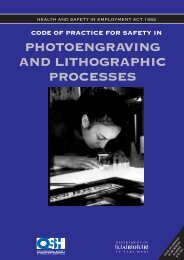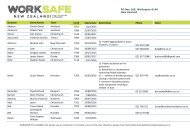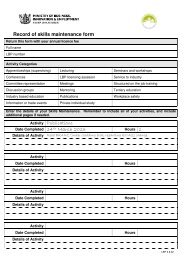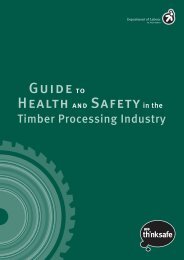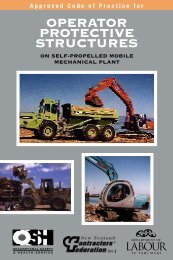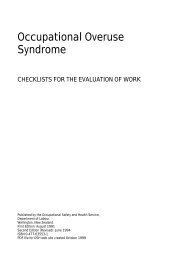Fact Sheet - Quad bike summary - Business.govt.nz
Fact Sheet - Quad bike summary - Business.govt.nz
Fact Sheet - Quad bike summary - Business.govt.nz
You also want an ePaper? Increase the reach of your titles
YUMPU automatically turns print PDFs into web optimized ePapers that Google loves.
QUAD BIKESAFETYSUMMARYwhy itmattersThese stories arebased on real eventsThe headlines – what you need to know to keep safe<strong>Quad</strong> <strong>bike</strong>s are commonly referred to as ATVs but in reality they are not really all terrainvehicles – they can’t go everywhere, or do everything. Respect their limits, and make sureeveryone on your farm follows the safety steps included in the guidelines.The safety steps you need to know are summarised here, but more detailed information can befound in the guidelines.!!!!!!Before you ride ask yourself whetherthe quad is the right vehicle for the job.Ensure riders are trained / experiencedenough to do the job.Always wear a helmet.Recognise dangerous areas byestablishing ‘no-go zones’.Don’t carry passengers.Don’t let kids under 16 ride adultquad <strong>bike</strong>s.Check the operating condition of thequad <strong>bike</strong> before you ride.! !What is the relationship between the guidelinesand the Act?WorkSafe New Zealand’s Safe use of <strong>Quad</strong> BikeGuidelines are not law, but may be used by theCourts to help decide whether or not someone hastaken reasonable steps to prevent serious harm asrequired by the Health and Safety in EmploymentAct 1992. If you follow the Guidelines, it is likelythat you will be able to show that you are keepingpeople on your farm safe around quad <strong>bike</strong>s.You may find that some of the safety steps in theGuidelines seriously challenge the way you’vealways used quad <strong>bike</strong>s. With the exception ofwearing protective equipment (helmets) and riderKeep quad <strong>bike</strong>s maintained ina safe condition.Keep within the manufacturer’s towing orcarrying limits.Only use attachments designed for andcompatible with the quad <strong>bike</strong>.Don’t do tasks that interfere withsafe riding.Tell someone where you are going.Avoid use while fatigued or under stress.Restrict unauthorised access to thequad <strong>bike</strong>.training/supervision which are specifically requiredin the Act, you are still able to put in place safetymeasures that differ from those set out in theseGuidelines – as long as they achieve the same orhigher level of safety for people.If you do this, be aware that you’ll need to be ableto explain why you took a different action insteadof what was stated in the guidelines – especially ifsomething goes wrong. The responsibility to makesafe decisions remains with you.Ignoring the information in the guidelines and notdoing anything to manage risk is just not an option.For more information and to read the full Guidelines for the Safe Use of <strong>Quad</strong> Bikesplease visit worksafe.<strong>govt</strong>.<strong>nz</strong>!!!!!!Not taking time to assess ridercompetency hurtsIt was Beth’s first day on the job. She was askedto borrow a quad <strong>bike</strong> from a neighbour and ridedown the road to a distant part of the farm. Shehad been given a basic demonstration on howto use a quad <strong>bike</strong> previously and the neighbourchipped in with information on the features of thatparticular quad. No one bothered to give her ahelmet.Beth never returned. She was found with headinjuries just off the road at the entrance to thefarm paddock. Luckily she survived, but herinjuries have left her unable to concentrate, andshe suffers from crippling headaches and moodswings that make it difficult for her to hold downa job.In this case, the employer could havereduced the risk of an accident by simplychecking the capability of a new employee toride a quad <strong>bike</strong> and supervising her untilshe was a competent rider.A brief demonstration on how to ride a quad <strong>bike</strong>is not enough. At a minimum Beth should havebeen observed riding on the type of terrain shewas expected to encounter.Wearing a helmet is also an obvious step thatprobably would have prevented her injuries frombeing permanent and life-changing.A chance for brothers to betogether goes sourDaniel was enjoying his first job working on afamily friends’ farm. He was really proud to showhis 10 year old brother Nicky what he could dowhen he came to stay during the holidays. Whenit came time to shift the electric fences they bothjumped onto the quad <strong>bike</strong> and rode to the backpaddock. Of course as brothers do, Dan wasshowing off and made sure they wove in and outof a nearby ditch as they travelled on the quad<strong>bike</strong> together.If Nicky had not been on that quad <strong>bike</strong>, then Danwould have ridden differently. The <strong>bike</strong> would nothave flipped, and Dan would not have had theawful experience of having his little brother die inhis arms at the scene.Passengers on quad <strong>bike</strong>s are a danger – theiradded weight and movement affects theperformance of the <strong>bike</strong>, and can also restrict therider’s movements at the crucial moment withdisastrous consequences.Keep our children safeSaving up for his own motor<strong>bike</strong>, David was keento earn a bit of money. To do this, he was workingon the family’s dairy farm feeding calves. His workinvolved using a quad <strong>bike</strong> and trailer to carrybags of meal and a calf feeder. When the trailerwas not attached he could take the <strong>bike</strong> for a spin.David was only thirteen, how was he supposed totruly understand the limitations of a quad <strong>bike</strong>?All he knew was that tight turning circlescombined with high speed equals some seriousthrills. The result was predictable – he was killedwhen the <strong>bike</strong> rolled on top of him.He should not have been riding that quad <strong>bike</strong>.Manufacturers set age limits for a reason and it’snot just the size of the child or the amount oftime they have been using the quad <strong>bike</strong>. It’s acombination of physical, mental and social factorsthat only come together in the majority of childrenat sixteen.A few simple steps could haveprevented a stay in hospitalRob was a dairy herd manager in the Waikatoregion setting off to repair a fence. In a hurry, hethrew the tools onto the front of the quad <strong>bike</strong> androde one-handed to hold them in place. As usual,he ignored the helmet gathering dust in the shed.You can imagine the result when the quad <strong>bike</strong> hita pothole – Rob couldn’t keep control, and rolledthe <strong>bike</strong>. He regained consciousness in hospitalwith serious head injuries.What Rob could have done to avoid the <strong>bike</strong>rolling in the first place was to control the <strong>bike</strong>with both hands. All he needed to do was takea few seconds to secure the load before settingoff. And, if the <strong>bike</strong> had still rolled and he had beenwearing the helmet, he would probably only havehad a bit of a headache to deal with, instead of apermanent injury.


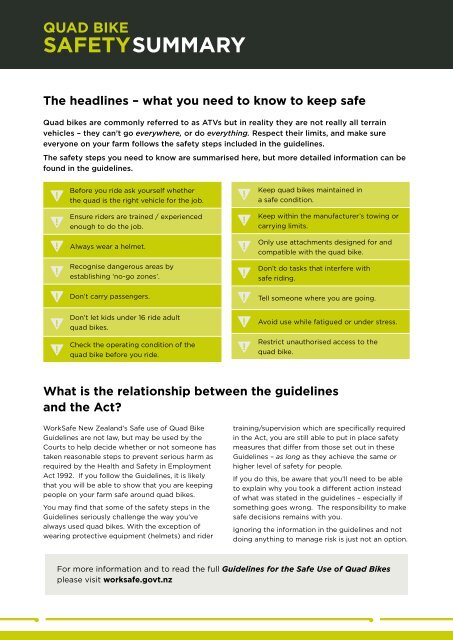


![Task analysis worksheet [161 KB PDF] - Business.govt.nz](https://img.yumpu.com/51400981/1/190x135/task-analysis-worksheet-161-kb-pdf-businessgovtnz.jpg?quality=85)

